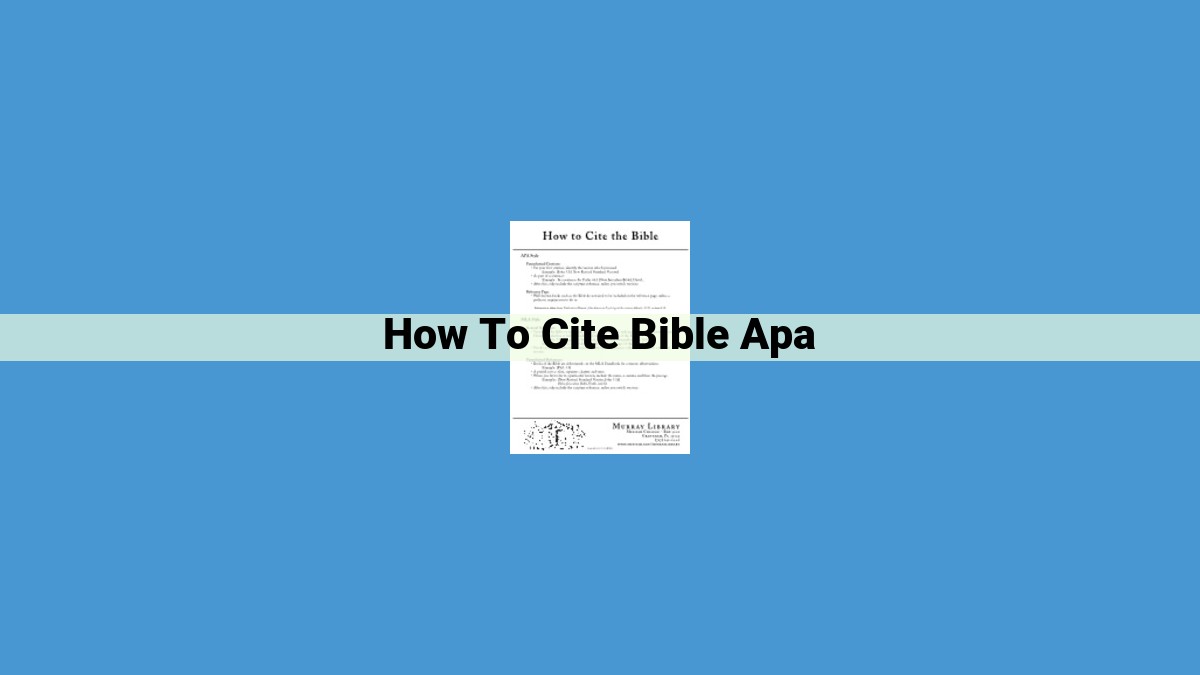- Cite the Bible in APA style to ensure accuracy and credibility.
- Include book, chapter, verse, author (if provided), translation, and year of publication.
- Use specific formatting for parenthetical citations and reference list entries, and refer to real-world examples for clarity.
Citing the Bible Accurately: An APA Style Guide
In the realm of academic writing, precision and accuracy are paramount. When referencing sacred texts like the Bible, it becomes even more crucial to cite the source correctly. This APA Style Guide for Biblical Citations aims to empower you with the knowledge and tools you need to cite the Bible seamlessly in your academic endeavors. By following these guidelines, you not only demonstrate your respect for the text but also ensure the integrity and credibility of your work.
Components of a Biblical Citation
Every Biblical citation consists of specific elements that provide essential information about the source. These elements include:
- Book: The specific book of the Bible from which the verse is taken (e.g.,
Genesis) - Chapter: The chapter number where the verse is located (e.g.,
1) - Verse: The specific verse being cited (e.g.,
1) - Translation: The version or translation of the Bible used (e.g.,
New International Version) - Year of Publication: The year the translation was published (e.g.,
2011)
It is important to note that the order of these elements may vary depending on the specific citation style being used.
Components of a Biblical Citation: A Comprehensive Guide
When crafting a Biblical citation, accuracy is paramount. APA style, widely employed in academia, provides a standardized framework for referencing biblical texts. Understanding the essential components of a Biblical citation is crucial to ensure its validity and credibility.
Let’s delve into the key elements that constitute a comprehensive Biblical citation:
Book
The book refers to the specific portion of the Bible being referenced, such as Genesis, Psalms, or Revelation.
Chapter
The chapter denotes the designated section within a book. For instance, in the citation “Genesis 1:1,” the chapter number is “1.”
Verse
The verse pinpoints the specific passage within a chapter. In the same citation, the verse number is “1.”
Author
The author of the Biblical text is typically not explicitly stated in the citation, as the Bible is considered to be inspired by God.
Translation
If a specific translation of the Bible is used, it should be indicated in the citation. For example, “New International Version” (NIV) or “King James Version” (KJV).
Year of Publication
The year of publication is included in the citation only if the specific translation being referenced has a known publication date.
By meticulously citing Biblical texts using these essential components, researchers and scholars can ensure the accuracy and consistency of their references, allowing readers to effortlessly locate the exact passages mentioned in their work.
APA Style Citation Format for the Bible
When citing the Bible in APA style, meticulous attention to formatting is crucial for academic integrity and clarity. This guide will delve into the specific requirements for both parenthetical citations and reference list entries, empowering you to incorporate Biblical references seamlessly into your writing.
Parenthetical Citations:
In text, parenthetical citations succinctly indicate the Biblical passage being cited. The format is as follows:
- Book chapter:verse (Year of Translation)
For example: (Genesis 1:1, NIV 2011)
Reference List Entries:
The reference list entry provides complete publication information for the Bible translation used. It appears at the end of your paper and follows this general format:
- Bible. (Year of Translation) English Standard Version. Zondervan.
Examples:
- Parenthetical Citation: (John 3:16, ESV 2016)
- Reference List Entry: Bible. (2016) English Standard Version. Zondervan.
Tips:
- Use italics for the book titles.
- Abbreviate the chapter as “ch.” and the verse as “v.” for multiple citations from the same chapter or verse, respectively.
- For citations from multiple versions, include the version abbreviations in the reference list entries and cite as follows: (Genesis 1:1, KJV; NIV 2011)
By following these formatting guidelines, you ensure that Biblical references are correctly cited and seamlessly integrated into your writing. This not only demonstrates your academic rigor but also allows readers to easily locate the cited passages for further study. Embrace these guidelines and elevate the accuracy and clarity of your writing by citing the Bible effectively in APA style.
Examples:
- Provide real-world examples of properly formatted Biblical citations.
Examples of Properly Formatted Biblical Citations
Let’s explore some examples to solidify your understanding of Biblical citations in APA style.
Example 1: Parenthetical Citation
When referencing a specific passage from the Bible within your text, use a parenthetical citation. For instance, if you’re citing Romans 8:28, the citation would look like this:
(Romans 8:28, New International Version, 2011)
Note: Include the book, chapter, verse, translation, and year of publication in the parenthetical citation.
Example 2: Reference List Entry
In your reference list, create an entry for the complete Bible version you used. Here’s an example for the New International Version (NIV) published in 2011:
Bible. New International Version. (2011). Zondervan.
Remember: Place the reference list entry in alphabetical order by book title or, if not available, by the first word of the title.
